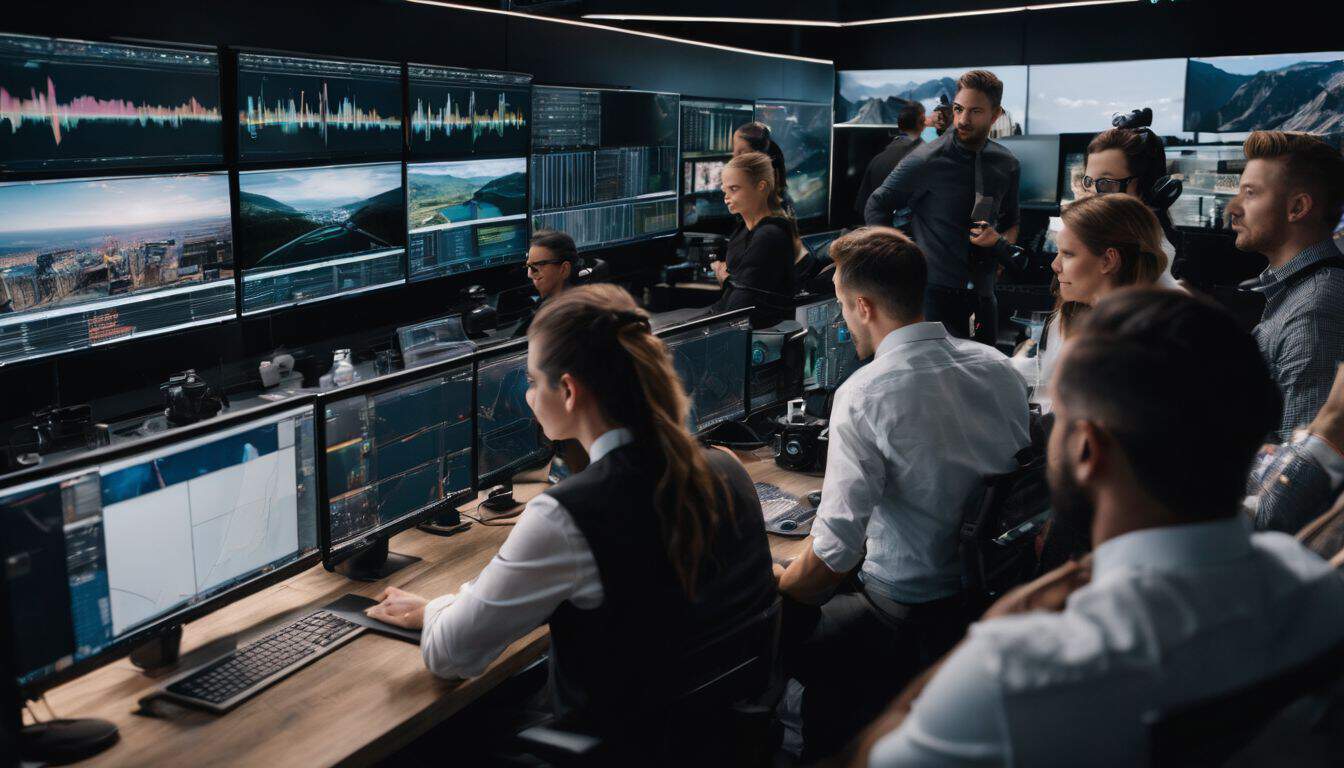Experiencing an unexpected emergency when you feel cut off from the rest of the world can be a nerve-wracking experience. Believe me, it’s like navigating your way in the dark. Recalling one such instance, it felt like eternity before I could access crucial information due to lackluster communication channels at hand.
Through this blog post, my aim is to share some practical do-it-yourself (DIY) emergency communication methods and three empowering ways to perfect these skills. So let’s buckle up and dive right in – because being prepared means never having to feel helpless when chaos strikes again!
Key Takeaways
- Have an emergency communications plan in place to ensure you can pass on important details during a crisis. This plan should include steps to take, who to contact, and the best ways to share news.
- Build an effective emergency communications plan by forming a dedicated team, investing in technology for monitoring threats, coordinating your crisis communication plan, reaching people through all available channels, and understanding your audience.
- DIY emergency communication methods include preparing a family communication plan, having multiple methods of communication (such as amateur radio and satellite phones), using social media and mobile apps during emergencies, relying on cell phones or landline telephones for non-emergency and power outage situations respectively.
What Is an Emergency Communications Plan?
An emergency communications plan gives you a clear path to pass on important details in times of crisis. It holds things like what steps to take, who should be contacted and how, and the best ways to share news during emergencies.
This type of plan is like a map that points out which road to take when danger comes.
To keep your family safe, having an emergency communications plan is key. Not all disasters happen at the same time or place. Your family may not be together when there’s danger so knowing how to reach each other can mean a lot.
Imagine if you miss your nightly call with mom during a storm or power outage because you didn’t have this kind of plan! So it’s worth every effort to come up with one for your loved ones’ security and peace of mind.
Building an Effective Emergency Communications Plan

To build an effective emergency communications plan, start by forming a dedicated team and investing in the necessary technology to monitor threats. Coordinate your crisis communication plan and ensure you reach people through all available channels.
Understand your audience and script messages ahead of time for efficient communication during emergencies.
Forming an emergency communications team
Forming a skilled emergency communications team is a key step. The team should have people trained in how to talk well during bad events. They will be the ones to give out all important info when there’s an emergency.
The role of this team is very big! They help make sure that all crisis plans are going smooth and fast. Plus, they check that messages reach the right people at the right time. This helps keep everyone safe and calm during any kind of emergency.
It’s like building a strong net to catch us when things go wrong!
Investing in emergency communication technology
We put money into emergency communication technology. It is a key part of our plan to stay safe in an emergency. Good tech helps us send and get messages fast. We also know what happens around us at all times.
This makes it easier for us to respond right away if there’s danger or help needed. Clear and quick communication can save lives during crises, so this step is very important.
Implementing a threat monitoring system
Implementing a threat monitoring system is an essential part of building an effective emergency communication plan. It helps identify and assess potential threats in real-time, allowing for quick response and action.
By utilizing security monitoring systems and technology, such as surveillance cameras, motion detectors, and intrusion alarms, you can enhance the safety and security of your survival space.
These systems provide valuable information about any potential dangers or risks, enabling you to coordinate your crisis communication plan more efficiently. With a threat monitoring system in place, you can stay prepared and respond promptly during emergencies.
Coordinating your crisis communication plan
To ensure effective emergency communication, coordinating your crisis communication plan is essential. This involves forming an emergency communications team that can handle crisis situations efficiently.
By collaborating with others, sharing information, and working together towards a common goal, the team can effectively manage any situation that arises. Additionally, implementing a threat monitoring system allows you to stay updated on potential risks and emergencies in real-time.
This helps you respond quickly and make informed decisions during a crisis. By coordinating your crisis communication plan effectively, you can minimize confusion, panic, and misinformation while maximizing the safety and preparedness of everyone involved.
Reaching people through all communication channels
To build an effective emergency communications plan, it’s important to reach people through all communication channels. This means using different methods to make sure everyone gets the message.
Whether it’s social media, mobile apps, cell phones, landline telephones, or even word-of-mouth, selecting the right channel for each situation is crucial. By understanding your audience and scripting messages ahead of time, you can ensure that information is disseminated quickly and efficiently during a crisis.
The goal is to keep everyone informed and safe by using a variety of communication channels that work best for your community or organization.
Understanding your audience
As a survival enthusiast, it’s important to understand your audience when building an effective emergency communications plan. This means considering factors like cultural awareness, linguistic diversity, geographical location, and core values.
By understanding these aspects, you can tailor your communication to resonate with different groups of people.
One key element is ensuring accessible communication for everyone. Take into account the needs of individuals who may have disabilities or limited access to certain communication mediums.
Additionally, think about the most effective messaging for each audience and choose appropriate channels to reach them. This could include text messages, email notifications, social media platforms, or even word-of-mouth.
Remember that in emergency situations, clear and concise information is crucial. Make sure your messages are easy to understand and provide important details without overwhelming the recipients.
Scripting messages ahead of time
When it comes to building an effective emergency communications plan, one important aspect is scripting messages ahead of time. By preparing messages in advance, you can ensure that the right information is conveyed to your target audience during emergencies.
This involves crafting clear and concise messages that address the situation at hand and provide necessary instructions or updates. It’s crucial to determine the suitable communication method for each specific situation and plan accordingly.
Scripting messages ahead of time helps in streamlining emergency response efforts, facilitating quick and efficient communication, and ensuring that everyone receives the necessary information when they need it most.
Basics of DIY Emergency Communication Methods
Let me tell you about the basics of DIY emergency communication methods. Here are some important things to know:.
– Prepare a family communication plan for emergencies.
– Have at least three different methods of communication in your plan.
– Use alternative forms of communication like amateur radio, family band radios, satellite phones, and landlines.
– Avoid making phone calls unless it’s a serious emergency; use text messages for non-emergency communication.
That’s all for the basics of DIY emergency communication methods.
Exploring Emergency Communication Methods
In this section, we will delve into a variety of emergency communication methods, including social media, mobile applications (apps), cell phones, landline telephones, satellite phones (satphones), two-way radios, Citizens Band Radios (CB radios), Amateur Radios (HAM radios), police scanners, and the power of word-of-mouth.
Social media
Social media is a powerful tool during emergencies. It helps enhance other communication methods and allows people to share information and resources in real time. During emergencies, social media can be used to inform and educate, monitor health statuses, discuss social justice issues, and raise awareness.
It plays a significant role in disaster management by providing a platform for communication networks and public awareness.
Mobile applications (apps)
Mobile applications, or apps, are an essential tool for emergency communication. These apps can connect you with emergency services, share your location in real-time, and provide important updates and alerts.
With push notifications, these apps can quickly alert subscribers and bring them into the app for emergency information. They often include a panic button that allows you to send an emergency alert with just one tap.
Designing mobile apps for emergencies requires understanding the most efficient ways to notify users in urgent situations. These apps have been used in different contexts, including tourist-oriented applications, and they can be incredibly helpful during disasters or other emergencies.
Cell phone
Cell phones are essential tools for emergency communication. They can be a lifeline during a crisis, with 40% of cell owners finding them useful in emergencies. They have both positive and negative impacts on communication skills.
During disease disasters, mobile phone data can be analyzed to understand social communication patterns and spread information about preventive measures. When it comes to emergencies, non-voice communication methods such as text messaging, email, or social media are recommended.
These methods help overcome challenges in natural disasters where effective communication strategies play a vital role in ensuring everyone’s safety and well-being.
Landline telephone
Landline telephones are an important DIY emergency communication method that can be relied upon during power outages. Unlike cell phones, landlines still work even when the electricity goes out, ensuring you have a way to reach emergency services and loved ones.
Emergency responders also prefer landlines because they provide better monitoring capabilities and sound clarity. Another advantage of landline phones is that they are associated with a specific address, making it easier for emergency services to locate you in times of need.
So, having a landline phone can be crucial for keeping your family safe and connected during weather emergencies. It’s essential to include this reliable communication method in your overall emergency preparedness plan for increased peace of mind.
Satellite phone (satphones)
Satellite phones, also known as satphones, are an important communication option, especially in remote areas or during mission-critical situations. They can act as a backup method for emergency services when other forms of communication fail.
The reliability of satellite phones is impressive; they are rarely disrupted by natural disasters or human actions. This makes them incredibly useful during times of crisis when traditional communication methods may not be available.
Satellite phones can truly be lifesaving devices, providing a reliable connection and access to emergency alerts. While they can be costly, their reliability and ability to keep you connected during emergencies make them worth considering for your DIY emergency communication plan.
Two-way radio
Two-way radios are an important tool in emergency communication. They allow you to send and receive information, which is crucial during natural disasters like earthquakes. To effectively use a two-way radio, it’s important to familiarize yourself with how it works.
Take part in emergency drills to practice using the radio and improve your communication skills. Having clear and reliable communication capabilities is essential for an effective emergency response.
So, make sure you know how to use a two-way radio in case of emergencies.
Citizens Band Radio (CB radio)
CB radio is a form of emergency communication that allows people to talk over short distances. It’s like a private walkie-talkie system. CB radio is commonly used by truckers and state officials, like police officers, for quick and direct communication.
In emergencies, CB radio can be relied upon for two-way communication between different parties. It falls under the Personal Radio Service category and uses specific radio channels for communication.
Amateur Radio (HAM radio)
Amateur radio, also known as HAM radio, is a vital communication method during emergencies and natural disasters. When other forms of communication like phones or internet are not available, ham radio operators step in to provide crucial connections.
As a survival enthusiast, having knowledge of amateur radio can greatly enhance your emergency preparedness. In times of crisis, ham radio operators play a crucial role in providing public service and helping coordinate the response efforts.
They use specific frequencies dedicated to emergency communications, ensuring effective and reliable communication when it matters most. So whether you’re preparing for a disaster or simply want to stay connected in remote areas, learning about amateur radio is an important step towards being well-equipped for any situation.
Police scanner
A police scanner is a special radio receiver that allows you to listen to two-way radio calls made by police officers and other emergency response personnel. It’s an important communication tool used by these officials to stay connected with each other and their dispatchers.
During emergencies, like natural disasters or accidents, police scanners become even more crucial as they provide real-time updates on the situation. Many preppers also use police scanners as part of their emergency preparedness plans.
They are able to monitor communication between officials from various agencies, helping them stay informed and make better decisions in times of crisis.
Word-of-mouth
When it comes to emergency communication, word-of-mouth can be a powerful tool. It involves sharing information orally through conversations with others. During an emergency, word-of-mouth can help quickly spread important messages and instructions to a wide audience.
It is especially effective in situations where traditional communication channels may not be available or reliable. In addition to social media and other communication methods, word-of-mouth marketing plays a crucial role in getting emergency messages out to the public.
By leveraging the power of personal networks and trusted relationships, word-of-mouth helps create public awareness and ensures that critical information reaches those who need it most.
Benefits of DIY Emergency Communication Methods
DIY emergency communication methods offer quick and efficient communication, increased safety and preparedness, as well as cost-effective solutions for emergencies.
Quick and efficient communication
When it comes to emergencies, quick and efficient communication is crucial. DIY emergency communication methods can help ensure that critical information and updates are sent and received promptly.
One way to achieve this is through text messaging or SMS, which allows for rapid communication with multiple people at once. By keeping phone calls brief and limiting non-emergency calls, you can also help maintain efficient communication during a crisis.
It’s important to develop a disaster communication plan in advance so that everyone knows how to quickly relay important messages when needed. With DIY emergency communication methods, you can be prepared for any situation and communicate effectively in times of need.
Increased safety and preparedness
Ensuring safety and preparedness is crucial during emergencies. DIY emergency communication methods can greatly contribute to achieving this goal. By implementing these methods, you can have quick and efficient communication in critical situations, allowing you to respond effectively.
Whether it’s through social media, mobile applications, cell phones, or two-way radios, having multiple communication channels increases your chances of getting important information across.
This prepares you for any unforeseen events and helps keep everyone safe. Furthermore, utilizing cost-effective solutions like these can help ensure that even with limited resources, you are still able to establish reliable communication networks.
Cost-effective solutions
When it comes to emergency communication, there are cost-effective solutions available that can help you stay connected during a crisis. One option is to use low-tech devices like family band radios or landline phones, which don’t require an internet connection and can be more reliable in certain situations.
Another cost-effective solution is to take advantage of smartphone apps that allow for free messaging and calling over Wi-Fi networks. These apps can help you save on cell phone minutes and data usage during emergencies.
Additionally, investing in emergency preparedness equipment like portable solar power chargers or hand-crank radios can provide long-term cost savings by reducing reliance on traditional power sources.
Best Practices for Mastering DIY Emergency Communication
Regular practice and drills are essential for mastering DIY emergency communication. Use emergency communication software and keep your communication equipment in good condition. Stay updated on emergency protocols and prioritize clear and concise messaging.
Regular practice and drills
Regular practice and drills are key to mastering DIY emergency communication methods. By participating in practice sessions, you can enhance your emergency preparedness and improve your communication techniques.
These exercises help you become familiar with different communication methods and ensure that you can effectively respond during critical events. Through regular training programs and exercise programs, you can evaluate the functionality of technology, strengthen your response capabilities, and refine your communication strategies.
So don’t underestimate the importance of regular practice and drills – they are crucial for being prepared when it matters most.
Emergency communication software
Emergency communication software is a valuable tool for mastering DIY emergency communication. With options like AlertMedia, Everbridge Mass Notification, and Text-Em-All, you can quickly and efficiently send alerts and messages to your team or community during emergencies.
These software options allow you to keep your communication up-to-date, ensuring everyone receives important information in real-time. Having reliable emergency notification software is crucial for coordinating relief efforts and keeping people safe during disasters.
So, consider investing in emergency communication software as part of your overall preparedness plan.
Keeping communication equipment in good condition
Maintaining communication equipment is crucial for effective DIY emergency communication. When communication devices are in good condition, they can reliably transmit messages during emergencies, ensuring quick and efficient communication.
By regularly checking and servicing your equipment, you can prevent breakdowns and ensure that it functions properly when needed most. This includes inspecting cables, batteries, antennas, and other components to make sure they’re in good working order.
Additionally, keeping spare parts on hand can be helpful in case of any unexpected issues. By prioritizing equipment maintenance, you can enhance your emergency preparedness and improve the reliability of your communication systems.
Staying updated on emergency protocols
To effectively communicate during emergencies, it is important to stay updated on emergency protocols. This means keeping yourself informed about the guidelines and procedures that should be followed in different emergency situations.
By staying updated, you can ensure that your communication efforts align with the latest protocols recommended by local authorities and emergency response organizations. The FCC and FEMA provide helpful tips and resources for communicating during emergencies, including preparation and response guidelines.
So, make it a priority to regularly check for updates on emergency protocols to ensure that your DIY emergency communication methods are in line with the best practices.
Prioritizing clear and concise messaging
When it comes to DIY emergency communication, prioritizing clear and concise messaging is crucial. During an emergency situation, every second counts and the information you convey needs to be easily understood and actionable.
To achieve this, it’s important to plan ahead and script your messages in advance. This ensures that you can quickly communicate important details without wasting time trying to figure out what to say.
Clear messaging helps avoid confusion or misinterpretation, allowing everyone involved to understand the situation and take appropriate actions promptly. By focusing on clear and concise messaging, you can effectively communicate during emergencies and increase the chances of a successful outcome.
Conclusion on DIY Emergency Communication Methods
In conclusion, mastering DIY emergency communication methods is essential for being prepared in times of crisis. By forming a strong emergency communications team, investing in the right technology, and understanding your audience, you can effectively communicate during emergencies.
Remember to practice regularly and stay updated on protocols to ensure clear and concise messaging. With these three ways mastered, you’ll be better equipped to handle any emergency situation that comes your way.
Stay safe!
Downloadable Resources for DIY Emergency Communication
I found some helpful downloadable resources that you can use for DIY emergency communication. These resources are available in English and Spanish, and they are free to download. Here are the resources:.
– Communication aids for emergency situations
– Educational program on emergency preparedness for grades 6-8
– Accident prevention resources for different situations and environments
That’s it!
Additional Resources and Articles
I have found some additional resources and articles that you might find helpful when it comes to DIY emergency communication methods:
– “Emergency Preparedness: Communication Strategies” – This article provides useful tips and strategies for effective communication during emergencies.
– “Disaster Response: Community Outreach and Public Information” – Learn about the importance of reaching out to your community and providing vital information during a disaster.
– “Crisis Management: Communication Tools for Emergency Situations” – Discover different tools and technologies that can enhance your crisis management efforts.
– “Emergency Notifications: How to Disseminate Information Quickly” – Find out how you can quickly and efficiently notify people about emergencies using various communication channels.
– “Household Safety: Importance of Having Key Contacts in Your Phone” – Learn why it’s crucial to have important contacts saved in your phone during emergency situations.
That wraps up the additional resources and articles I’ve found. I hope you find them helpful!
Importance of Effective Communication in Emergency Situations
In emergency situations, effective communication is extremely important. It allows emergency responders to quickly gather the essential information they need about patients and the situation at hand.
With good communication, critical information can be exchanged in real-time, ensuring that everyone involved is on the same page. Having a clear and concise family communication plan is crucial during disasters, as it helps everyone stay connected and informed about what to do.
Good communication also plays a vital role in emergency coordination and response efforts. By prioritizing effective communication strategies and following established protocols, we can better manage crises and ensure the safety of those affected by emergencies.
FAQs on DIY Emergency Communication Methods
1. What are DIY emergency communication methods?
DIY emergency communication methods refer to ways of communicating during emergencies using simple and accessible tools or techniques that can be done without professional help.
2. Why should I learn DIY emergency communication methods?
Learning DIY emergency communication methods is important because it allows you to stay connected and communicate with others during times when traditional forms of communication may not be available, such as power outages or natural disasters.
3. What are the three ways to master DIY emergency communication methods?
The three ways to master DIY emergency communication methods include learning Morse code for signaling, practicing radio operation and using portable radios, and developing basic knowledge of hand signals for visual communications.
4. How can I learn Morse code for signaling in emergencies?
You can learn Morse code by studying online resources or mobile apps that provide tutorials and practice exercises. Practicing regularly will help you become proficient in translating and sending messages using Morse code signals.
5. Where can I get a portable radio for emergency communications?
Portable radios can be purchased from electronic stores, online retailers, or even second-hand shops. Look for models that have reliable reception capabilities and battery life suitable for extended use during emergencies.




Leave a Reply